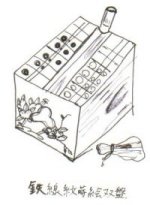|
¡Sugoroku Being Composed in Tanka SugorokuEEE"The Tanka Seasonal Words Glossary through All Ages" compiled by Torii Masahiro / Kyouiku-sha In the Nihon-shoki [Jitou 3rd] reads "prohibit and cease Sugoroku on
the day of tsuchi-no-tori-no-hinoe-tatsu in December" because it was
played for gambling. Although it had been played through the Medieval Age, Sugoroku became out of vogue in Edo era, disappeared in Bunka-bunsei period [1804-1829] and has been replaced by Paper Sugoroku. It began with "Buddhist Sugoroku" preaching Buddhist doctrines at first, then changed into "Pure Land Sugoroku", and into "Touring Sugoroku". It became kid's game since Meiji era. The Paper Sugoroku is made with a large paper partitioned in several blocks with pictures each, played with a dice making pieces forward according to the number from its start block, won by arriving goal faster than other players. There are not many poems in old days composing Sugoroku in. A verse
named "Sugoroku-ban-no-uta" in "Minamoto-no Shitagou-shu" reads "su-ku-ro-ku-i-chi-ba"
word played with the first and last syllable. The reason why Ozawa Roan
picked 15 poems is supposed to be the number of blocks on the board.
Should "Suguroku-ichiba (market)" imply a situation of gathering of
pieces like a market where cloud of people are gathering? Man-you-shu Not only 1 or 2, there also are 5, 6, 3 and 4It's a wonderful point
of Sugoroku A swelling on a cow saddle of Sugoroku
Growing up on the forehead of my wife The collection of Minamoto no Shitagou Suruga naru Fuji no kemuri mo haru tateba,
kasumi to nomi zo miete tanabiku [No. 52] Kusa shigemi hito mo kayowhanu yamazato
ni, ta ga uchiharahi tsukuru nawhasiro
[No. 53] Rokuro ni ya ito mo hikuram hikimayu no,
shiratama no wo ni nuke to tae nui [No.
54] Chiri mo naki Kagami no yama ni itodoshiku
yoso ni te mire domo, akanu momidhiba [No.
55] Shui-shu(follow-up of omissions) It won't end up without seeing her,Someone's wife standing in the
Sugoroku market Roku-djou-ei-sou / The verse of Suguroku by Ozawa Roan Suma no ura Hatsuse no yama mo hedate
naku, haru no kasumi ha kesa ya tanabiku Kuniguni ni nadataru tokoro ookare do
hana wha miyako no haru no yamashiro Roukoku no hodo mo naku nomi mori te
yo wha, tamakura no a ni akuru natsu no i Ichijiruku tsuyu okisome te kono asake,
kuru aki miyuru miwha no kayohidhi Chidhi no aki, hitotsu no tsuki no yukikaheir,
kawharajii miyo wo meguru hikariha Koe mata toki by Takeda Hiroyuki(Voice, sometimes Time) I carved two persons exactlyHow they are playing Sugoroku SugorokuEEE"Tanka Expression Dictionary, Chapter of life / culture" by editors of Iidsuka-shoten Oto no ko ga chiisaki te ni furu Sugoroku
no, sai yoku ide te hitori kachitugu Sugoruku: Its History and Culture TOP Copyright(c) TSUKIJI SUGOROKUKAN
|
 A game
which is told to have been born in India and brought via Tang Dynasty.
The original pronunciation was Suguroku. Dice holder in the center of
the game board, arrange 15 pieces each of black and white in a block
of 12 partition in the right and left, cast 2 dices from a cylinder,
make move according to the number, win when all pieces have moved in
the other's side. The size of the board was not unified, and there were
many variances in its rule, the number of pieces and the arrangements.
A game
which is told to have been born in India and brought via Tang Dynasty.
The original pronunciation was Suguroku. Dice holder in the center of
the game board, arrange 15 pieces each of black and white in a block
of 12 partition in the right and left, cast 2 dices from a cylinder,
make move according to the number, win when all pieces have moved in
the other's side. The size of the board was not unified, and there were
many variances in its rule, the number of pieces and the arrangements.